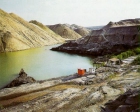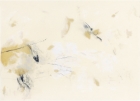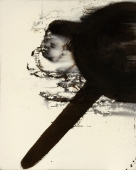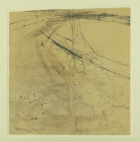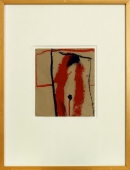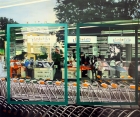
Artist | Inge Rambow (*1940)
https://www.artist-info.com/artist/Inge-Rambow
Biography
Biography
born 1940
About the work (english / deutsch) - Desertions / Wüstungen
About the work (english / deutsch) - Desertions / Wüstungen
The open-cast lignite mines, terrain that has not been recultivated, are to be found in three of the five federal states in eastern Germany, namely Brandenburg, Saxony and Saxony-Anhalt. Broadly speaking, they are located in the indirect vicinity of Dresden, Leipzig, Halle, Cottbus, and Berlin. Lignite extraction in eastern Gennany (in the former GDR) can be roughly sub-divided into a smaller region in central Germany near Leipzig and a larger area further east in Lusatia.
Lignite is the organic remains of palms and deciduous trees that started to decompose mainly during the Tertiary period. And there is a more than 200 year history of lignite mining in Lusatia. The first lignite was prospected in Lower Lusatia in 1789. Industrial-scale mining first began in 1880. There is documentary evidence of mining in the Central German lignitefields as early as 1795. As of 1880, the coal started to be extracted by hand there, too. From 1924 onwards, mining increasingly took the form of major open-cast extraction involving largescale machinery. In the Central German open-cast mines near Halle, there were close links to the coking and chemical industries in the Buna and Leuna plants.
Lignite was almost the only energy source for the GDR, and was therefore of immense importance. Electric power stations were all lignite-fired, supplying the electricity for industry, and lignite was also the fuel used for home heating purposes. The open-cast lignite mines were up to 200 meters deep. In particular, in the 1960s and 1970s, work to recultivate disused mines severely lagged behind creation of new mines. Efforts to make the arcas arable again were repeatedly postponed, with the official explanation that the authorities were waiting for the development of a new mining technology that would enable some mysterious fourth seam to be tapped at a very great depth. The ecological problems caused by this form of lignite mining in the GDR and the severe economic constraints under which it occurred are among the most severe environmental difficulties to be solved in eastern Germany today. A total area of some 380 square kilometers carefully demarcated in expert reports have been earmarked for recultivation work. Some 170,000 acres of the landscape have been profoundly changed or completely devastated, and more than half this figure, namely 95,000 acres have been left as dead wasteland or dumping areas.
The large-scale open-cast mining has left behind some 164 "remaining holes" in the deserted landscape that are especially difficult to recultivate, not to mention approx. 450 kilometers of slippery embankments that are dangerous to tread - about the same length as the autobahn from Nuremberg to Berlin.
Particular problems are caused by some 400 dumps in the holes left behind by open-cast mining, dumps that do not rest on sealed ground so that the waste trickle into the groundwater. The waste is not only household refuse, but also highly toxic chemical residues from factories, among others in the triangular region formerly occupied by the chemical industry in eastern Germany many kilometers away. Old waste left by the lignite industry is thus old chemical waste, and vice versa. In the opinion of the experts, it is financially and technologically impossible to render these dumps completely safe. Each year, for example, in Lusatia 1.2 billion cubic meters of water were pumped out in order to keep the open-cast mines running. This continuous pumping led to a surface area of 740,000 acres lacking some 13 billion cubic meters of water, or more than thrice the amount stored in reservoirs throughout Gerinany. Suddenly "turning off the water regulation systems in order to let the remaining holes fill would lead to the dumps that do not have sealed walls coming into contact with the groundwater. Morcover, this would threaten groundwater supplies for all of Berlin and Brandenburg, as the water for these regions is tapped by means of ultrafiltration of Spree River water, which would probably dry up if water was diverted into the "holes".
Whereas in the past, for example in 1990, as many as 130,000 workers were employed in the mines, today the number is only 15,000, and they are engaged in restoration and recultivation of the mines.
Assuming some sort of success, the most favorable time-frame for the restoration work is some 50 years. According to cautious estimates and assuming the current value of money, the financial side to the recultivation will come to some DM 30 billion.
Wüstungen
Die nicht rekultivierten Braunkohlefolgelandschaften befinden sich in drei der fünf neuen Bundesländer (Brandenburg, Sachsen, Sachsen-Anhalt), im weiten Umfeld der Städte Dresden, Leipzig, Halle, Cottbus und Berlin.
Die Braunkohleförderung im Osten Deutschlands (ehemalige DDR) kann grob unterteilt werden in ein kleineres mitteldeutsches Abbaugebiet um Leipzig und ein weiter östlich gelegenes in der Lausitz. Braunkohle ist aus untergegangenen Palmen- und Laubholzwäldern, hauptsächlich des Tertiärs, durch Vermoderung entstanden.
Der Braunkohleabbau in der Lausitz hat eine mehr als 200jährige Geschichte. 1789 gab es in der Niederlausitz die ersten Braunkohlefunde. Die industrielle Nutzung begann 1880. Auch im mitteldeutschen Revier ist der Abbau schon ab 1795 nachgewiesen. Die Handbetriebsförderung erfolgte ab dem Jahre 1880. Seit 1924 wurde die Förderung nach und nach auf Großtagebau mit entsprechenden Großgeräten umgestellt. In diesem mitteldeutschen Revier um Halle erfolgte auch die enge Verflechtung mit der Schwel- bzw. Chemischen Industrie (Buna, Leuna ... ).
Für die DDR war Braunkohle der beinahe einzige und daher mit Abstand wichtigste Energieträger. Durch die Braunkohle erfolgte die gesamte Elektrizitätsversorgung für die industrielle Produktion sowie die Beheizung aller Haushalte.
Die Braunkohle wurde im Tagebau in Tiefen bis zu 200 Metern gewonnen. Insbesondere in den 60er und 70er Jahren entstand ein besonders hohes Rekultivierungsdefizit. Die Wiederurbarmachung wurde immer weiter hinausgeschoben mit der offiziellen Erklärung, daß man die Entwicklung einer neuen Abbautechnologiegeneration abwarten wolle, um dann ein geheimnisvolles Viertes Flöz ganz in der Tiefe abzubauen.
Die durch diese Form des unter massiven ökonomischen Zwängen stehenden Braunkohleabbaus in der ehemaligen DDR verursachten Umweltprobleme gehören zu den schwierigsten Aufgaben, die in den neuen Bundesländern gelöst werden sollen. Im eng eingegrenzten gutachterlich abgesicherten Umfang sind Flächen von ca. 380 Quadratkilometer zu sanieren. 70.000 Hektar Landschaft sind tiefgreifend verändert oder gänzlich devastiert, mehr als die Hälfte davon, nämlich 38.500 Hektar, blieben als tote Öd- oder Kippenflächen zurück. Insgesamt ca. 164 speziell problematisch zu sanierende Restlöcher hinterließ der Großtagebau in den verwüsteten Landschaften, zudem etwa 450 Kilometer nicht begehbarer, rutschgefährdeter Böschungen - eine Strecke so lang wie die Autobahn von Nürnberg nach Berlin.
Besondere Probleme bereiten ca. 400 gegenüber dem Grundwasser nicht abgedichtete Deponien in den Restlöchern ausgekohlter Tagebaue. Dort wurden neben Hausmüll auch hochgiftige chemische Abfälle aus den Fabriken u.a. des Chemiedreiecks z. T. über viele Kilometer Entfernung hinweg verfüllt. Die Altlasten der Braunkohle sind daher auch die Altlasten der Chemie und vice versa. Eine vollständige Entsorgung dieser Deponien ist nach Expertenmeinung weder finanziell noch technisch machbar.
Jährlich wurden zur Freihaltung der Tagebaue, beispielsweise der Lausitz, 1,2 Milliarden Kubikmeter Wasser abgepumpt. Durch dieses ständige Leerpumpen fehlen auf einer Fläche von 300.000 Hektar etwa 13 Milliarden Kubikmeter Wasser, das ist mehr als das dreifache der Menge, die in allen deutschen Talsperren zusammen gespeichert ist. Ein plötzliches Abschalten des Wasserregimes zur Freihaltung der Restlöcher hätte zur Folge, daß die dort lagernden nicht abgedichteten Deponien Kontakt mit dem Grundwasser bekommen. Darüber hinaus würde auch die Grundwasserversorgung ganz Berlins und Brandenburgs gefährdet, da diese aus dem Ultrafiltrat der Spree gewonnen wird, die dann möglicherweise trocken fallen würde. Hatten in den dortigen Revieren einstmals 130.000 Arbeiter gearbeitet (1990), so sind jetzt nur noch 15.000 mit der Sanierung und Rekultivierung beschäftigt.
Der zeitliche Rahmen der Sanierungsarbeiten einen möglichen Erfolg vorausgesetzt - beträgt günstigenfalls 50 Jahre. Die finanzielle Dimension der Sanierungsarbeiten wird in vorsichtigen Schätzungen nach heutigem Geldwert auf mindestens 30 Milliarden DM angenommen.
German text by Inge Rambow / Translation by Jeremy Gaines
(Extract - Full printed version available in the Museum)
MMK - Museum für Moderne Kunst, Frankfurt am Main
 offers / Requests offers / Requests  |
About this service |
|---|
 Exhibition Announcements Exhibition Announcements  |
About this service |
|---|
 Visualization |
Learn more about this service | ||
|---|---|---|---|

Interested in discovering more of this artist's networks?
3 easy steps: Register, buy a package for a visualization, select the artist.
See examples how visualization looks like for an artist, a curator, or an exhibition place: Gallery, museum, non-profit place, or collector.

Exhibition History

|
SUMMARY based on artist-info records. More details and Visualizing Art Networks on demand. Venue types: Gallery / Museum / Non-Profit / Collector |
||||||||||||
| Exhibitions in artist-info | 18 (S 2/ G 16) |
Did show together with - Top 5 of 389 artists (no. of shows) - all shows - Top 100
|
||||||||||
| Exhibitions by type | 18: 1 / 5 / 9 / 3 | |||||||||||
| Venues by type | 17: 1 / 5 / 9 / 2 | |||||||||||
| Curators | 7 | |||||||||||
| artist-info records | Oct 1975 - Dec 2024 | |||||||||||
|
Countries - Top 5 of 5 Germany (13) France (1) Hungary (1) Japan (1) United States (1) |
Cities - Top 5 of 12 Frankfurt am Main (7) Wiesbaden (1) Paris (1) Eschborn (1) Budapest (1) |
Venues (no. of shows )
Top 5 of 17
|
||||||||||
Curators (no. of shows)
Top 5 of 7
|
| Salinemuseum Halle | G | Sep 2024 - Dec 2024 | Halle (Saale) | (1) | +0 | |
| Bucerius Kunstforum | G | Jun 2021 - Sep 2021 | Hamburg | (13) | +0 | |
| Baumstark, Kathrin (Curator) | +0 | |||||
| Pohlmann, Ulrich (Curator) | +0 | |||||
| Tower - MMK | G | Mar 2018 - Jul 2018 | Frankfurt am Main | (10) | +0 | |
| Art Collection Deutsche Börse - Artists | S | Apr 2015 - Apr 2015 | Eschborn | (2) | +0 | |
| Kleinschmidt Fine Photographs | G | Sep 2011 - Oct 2011 | Wiesbaden | (77) | +0 | |
| DZ BANK [KUNSTSAMMLUNG] | G | Jun 2011 - Sep 2011 | Frankfurt am Main | (36) | +0 | |
| Sabau, Luminita (Curator) | +0 | |||||
| Keep reading |











